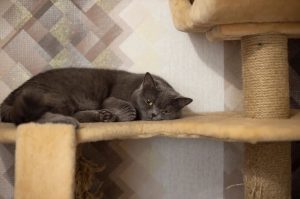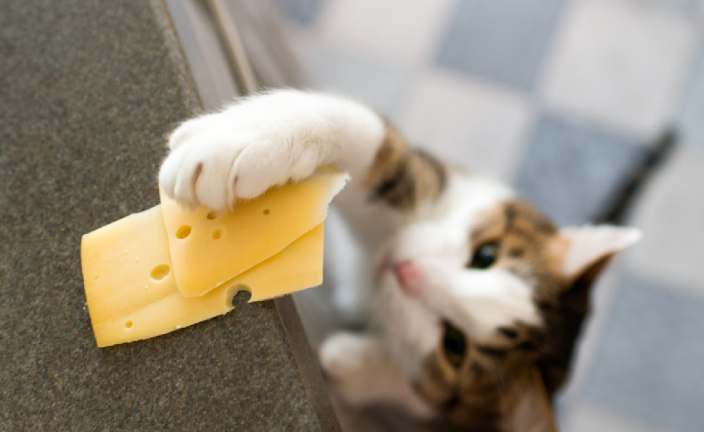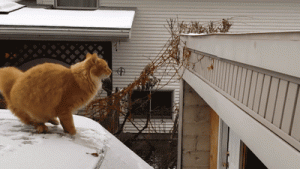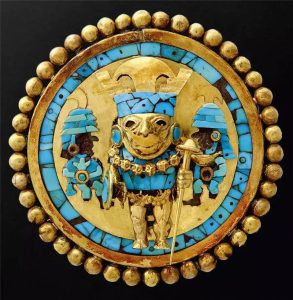On a leisurely evening when the rain taps gently on the glass windows, you snuggle up in a blanket, ready with snacks, a big glass of cola, and the movie you’ve been saving for a special moment. The moment the movie title appears on the screen, your cat jumps onto the coffee table, blinking its innocent big eyes, staring at your face, and letting out a soft “Meow~.” It’s a call to duty, a demand for attention. And you, exhausted, are left making a heart-wrenching choice between the movie and your playful cat. So, you pick the movie. The result? The “evil sugar-free steamed bun” gracefully lifts a paw, and with a “thud,” the ceramic cup filled with cola falls to the floor. In your ongoing battle with your cat, the cup is the innocent casualty. And this? This is already the third time this week that something has been knocked off the table in front of you. Whether it’s your carefully selected decorative item, the gaming controller you treasure, or the expensive face cream you worked hard to get, your cat, the “desktop cleanup master,” treats them all the same. Calmly staring at you while its paw continues its relentless poking and prodding. As you look at the mess on the floor, your blood pressure rises, and you can’t help but wonder: Does your cat’s mischievous paw always push things off the table out of curiosity or is it doing it on purpose?
-
“The Tool for the Crime,” an Essential Tool for Every Frequent Offender Cat
Every cat that frequently “commits crimes” has a trusty helper: their paw pads. With small, repeated exploratory actions and the mighty cat punch coming in with precision and power, every cat owner has likely seen a furry paw sneaking around their beloved items. In fact, this is just a cat’s way of exploring and experiencing the world. As born hunters, strategic and silent hunting is a fundamental skill for them. Their paw pads, full of nerve endings, allow them to feel the texture of various objects. The radial nerve controls the back of the cat’s forepaw, while the median and ulnar nerves control the paw’s underside. These nerves further branch out, ensuring that the cat’s curiosity is well-protected. If this important sensory tool is damaged, it would significantly impact the cat’s life. A study published in Experimental Biology analyzed the kinematic data of four adult female cats walking on a treadmill. It showed that when one paw pad was anesthetized, the cat’s center of gravity shifted to the anesthetized side. So, when your cat paws at a water cup or plays with a toy, it’s simply experiencing the beauty of being a cat. The three-layered paw pad structure, finely designed by nature, provides cats with a “padded” experience whether they’re “working from heights” or “working on the ground.” This allows them to elegantly escape from “crime scenes” with their tails between their legs and quickly vanish from your sight. Cats, with their mix of cuteness and mischief, have even perfected the art of frustrating humans.
-
The Path to Becoming an Excellent Hunter
Cats, with their tails held high, patrol the house, sniffing here and pawing there. The desire to explore, which starts in their kittenhood, doesn’t fade as they grow older. For cats, play is never just a pastime; it’s a concrete manifestation of their curiosity and a vital process in honing their hunting reflexes and agility. Kittens often use their front paws to gently tap (poke/slap) or grab and release objects. They may excitedly lift things with their paws to examine them closely. These repeated actions make cat playtime much longer than that of other carnivores. The poke/slap action, which moves objects, triggers the cat’s chasing instinct, and becomes a crucial part of their play. Researchers have found that 35% of play sessions begin with a poke/slap, often followed by another similar action, and these repetitions can occur up to 11 times. If an object falls while poking/slapping, you might notice your cat becoming more excited. This behavior is linked to their unique visual system. Cats perceive slow-moving objects poorly, with humans seeing movement at ten times the speed of cats. However, their vision is highly adapted to tracking fast-moving objects. Agile cats can track prey with rapid eye movements, showing their professional-level hunting skills. So, when your cat knocks over a small ornament from your table, the fleeting motion of the object triggers its instinct to chase fast-moving things. What you perceive as mischievous or deliberate behavior is, in fact, a thrilling challenge for your cat.

-
“Cat’s Secret Den” — They’re Just Bored
The skies are high and the seas vast, and in the wild, cats always find new things to explore. But for those indoor cats, their options for play become limited. After controlling similar feeding and care conditions, French researchers compared the activity patterns of indoor and outdoor cats over 21 days. They found that outdoor cats walked farther and had more frequent activity than indoor cats, with more nighttime exploration. In contrast, indoor cats had more pronounced “activity peaks,” showing a greater fluctuation between rest and activity. For cats feeling bored at home, any opportunity for play becomes an exciting event. Researchers observed different cats’ responses to prey-like toys such as balls, feather wands, and sound tests, and found that indoor cats showed much more interest in most stimuli. With limited opportunities, cats are eager to take whatever comes their way, and they treat every moment as an opportunity to play. So, when cats are left home alone for hours, lacking interaction and stimulation, they quickly get bored. To alleviate their boredom, these clever little creatures will start targeting your beloved belongings. One day it might be the TV, another day it might be scratching the couch, and one day, you may come home to find your limited edition Lego set smashed to pieces on the floor. For your cat, knocking things off the table provides a little mental stimulation that helps break the monotony of their indoor life.
-
The Problem Is You Too, Not Just the Cat’s Mischief
When your little indoor cat is left home alone, with its limited environment, waiting eagerly for you to come back and play, if you choose to ignore them, your cat has plenty of ways to make you pay. Researchers at the University of Adelaide’s Animal and Veterinary School used various surveys like the Cat Quality of Life Scale (QOL), Cat-Owner Relationship Scale (CORS), and Owner Game Trait Scale (APTS) to gather results from 1591 participants across 55 different countries. They found that providing cats with more frequent and varied games and toys significantly reduced boredom and improved their overall life satisfaction scores. Happy cats naturally develop better relationships with their owners. On the other hand, if an owner comes home, drops their socks, slumps on the bed, and ignores the cat, the cat will exhibit more attention-seeking behaviors: incessant meowing, or destructive actions. Some cats may even become distant and withdrawn. Either way, it signals that the cat is experiencing negative emotions. At this point, if your cat pushes a water cup to the edge of the table and you panic to stop it from falling, the cat may think, “Ah, I found a way to get attention. I’ll try this again.”
So, the next time your cat sincerely invites you to play, whether it’s with a movie or your phone, put it aside for a moment. Otherwise, the next time you come home, it might not just be the “shattered” limited edition Lego set waiting for you.





